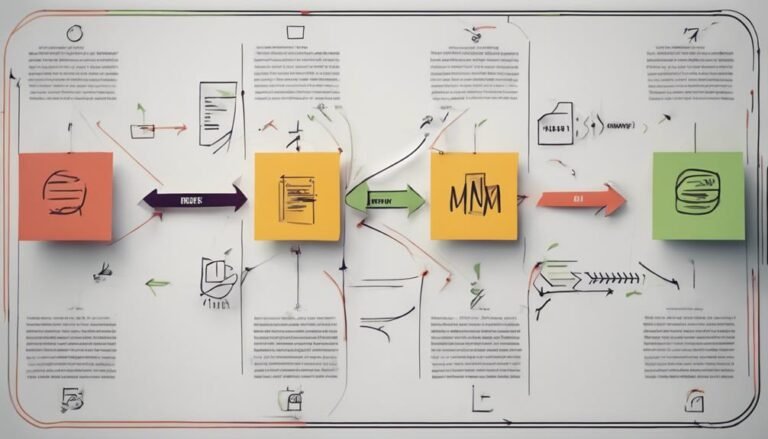Lean Management for SMEs
In today's competitive business landscape, Small and Medium Enterprises (SMEs) face the challenge of optimizing their operations to stay efficient and profitable. Lean Management offers a systematic approach that focuses on eliminating waste and maximizing value for customers.
By implementing Lean principles, SMEs can streamline processes, enhance productivity, and ultimately boost their bottom line. However, the successful integration of Lean practices requires a strategic mindset and a commitment to fostering a culture of continuous improvement.
How can SMEs adapt and thrive in an ever-evolving market through Lean Management practices?
Key Takeaways
- Lean principles drive waste elimination and value maximization in SME operations.
- Implementation of Lean tools boosts efficiency, reduces lead times, and cuts costs.
- Continuous improvement and team building foster innovation and competitiveness in SMEs.
- Employee empowerment and Lean leadership strategies enhance operational excellence and sustainable growth.
Understanding Lean Management
Understanding Lean Management is essential for small and medium-sized enterprises (SMEs) aiming to optimize their operations and enhance efficiency. Lean principles, rooted in eliminating waste and maximizing value, provide SMEs with a structured approach to streamline processes and enhance productivity. By embracing Lean principles, SMEs can identify and eliminate non-value-added activities, reduce lead times, and enhance overall operational efficiency.
Efficiency optimization lies at the core of Lean Management for SMEs. This involves continuous improvement efforts to streamline workflows, minimize resource wastage, and enhance customer satisfaction. Adopting Lean practices enables SMEs to identify bottlenecks, implement standardized processes, and foster a culture of continuous improvement within the organization. By focusing on efficiency optimization, SMEs can enhance their competitiveness, improve profitability, and drive sustainable growth in today's dynamic business environment.
Embracing Lean principles not only enhances operational efficiency but also cultivates a culture of innovation and adaptability essential for SMEs to thrive in competitive markets.
Benefits for SMEs
Efficiency optimization through Lean Management principles not only streamlines workflows and minimizes resource wastage but also offers significant benefits for SMEs seeking to enhance competitiveness and drive sustainable growth in today's dynamic business landscape. By focusing on efficiency enhancement and cost savings, Lean Management enables SMEs to eliminate non-value-added activities, reduce lead times, and enhance overall operational performance. This leads to a more agile and responsive business environment, allowing SMEs to meet customer demands more effectively and allocate resources efficiently.
Moreover, productivity improvement is a key outcome of Lean Management implementation for SMEs. By empowering employees to identify and solve problems, Lean fosters a culture of continuous improvement that enhances productivity levels across all organizational functions. As a result, SMEs can achieve higher output levels with the same resources, boosting their competitive advantage in the market.
In essence, embracing Lean Management principles equips SMEs with the tools and methodologies necessary to optimize operations, drive innovation, and achieve sustainable growth in a highly competitive business landscape.
Implementing Lean Tools
The successful integration of Lean tools into the operations of SMEs requires a systematic approach that aligns with the organization's strategic objectives and fosters a culture of continuous improvement. To effectively implement Lean tools, SMEs need to address various challenges and optimize processes.
Here are four key strategies for implementing Lean tools in SMEs:
- Identifying Lean implementation challenges: Understanding the unique obstacles that SMEs face when implementing Lean tools is crucial. These challenges may include limited resources, resistance to change, and a lack of expertise in Lean methodologies.
- Implementing Lean process optimization: SMEs should focus on streamlining processes to eliminate inefficiencies and enhance productivity. This involves mapping out current processes, identifying bottlenecks, and implementing improvements to optimize workflow.
- Developing Lean training programs: Providing comprehensive training programs for employees is essential to ensure successful Lean implementation. Training should cover Lean principles, tools, and techniques to empower employees to actively participate in process improvement initiatives.
- Focusing on Lean waste reduction: SMEs should prioritize the identification and elimination of waste in all forms, including excess inventory, overproduction, defects, and unnecessary motion. By reducing waste, SMEs can enhance operational efficiency and deliver greater value to customers.
Value Stream Mapping
Value Stream Mapping is a visual tool used to analyze and improve the flow of materials and information through the various processes involved in delivering a product or service. By creating a visual representation of the entire process from start to finish, organizations can identify areas of improvement, reduce lead times, and increase overall efficiency. This tool is instrumental in process optimization and waste elimination within a company.
| Benefits of Value Stream Mapping | Description | Purpose |
|---|---|---|
| Identifying bottlenecks | Pinpoints areas causing delays | Process optimization |
| Waste elimination | Highlights non-value adding steps | Waste reduction |
| Improved communication | Enhances understanding between teams | Collaboration |
| Enhancing customer value | Focuses on customer needs | Customer satisfaction |
Value Stream Mapping not only helps in streamlining operations but also fosters a culture of continuous improvement within the organization. By visualizing the entire value stream, businesses can make informed decisions to enhance their processes and deliver higher value to customers.
Continuous Improvement Culture
Fostering a continuous improvement culture within SMEs involves applying Kaizen principles to drive incremental enhancements. Implementing strategies to engage employees in the improvement process is also crucial. Utilizing effective problem-solving techniques plays a key role in this process.
These elements are crucial for SMEs looking to streamline operations, boost efficiency, and remain competitive in today's dynamic business environment. By focusing on these key points, SMEs can cultivate a culture of ongoing improvement that drives sustainable growth and success.
Kaizen Principles Application
Embracing a mindset of perpetual refinement is fundamental to instilling a culture of continuous improvement within SMEs through the application of Kaizen principles. By incorporating Kaizen principles, SMEs can foster a culture where every employee is encouraged to seek out and suggest small, incremental improvements continuously. This approach not only promotes continuous improvement but also cultivates a sense of ownership and accountability among team members.
To effectively apply Kaizen principles in SMEs, the following steps can be taken:
- Encourage open communication: Foster an environment where employees feel comfortable sharing ideas for improvement.
- Provide regular training: Equip employees with the necessary skills and knowledge to identify areas for enhancement.
- Implement feedback loops: Establish mechanisms for collecting and implementing feedback from employees.
- Recognize and reward progress: Acknowledge and reward employees for their contributions to continuous improvement efforts.
Employee Involvement Strategies
Building upon the foundation of Kaizen principles application within SMEs, developing effective employee involvement strategies is crucial for fostering a culture of continuous improvement and innovation. To achieve this, SMEs can focus on team building and communication strategies. Encouraging teamwork through collaborative projects and cross-functional teams can enhance employee engagement and creativity. Effective communication strategies, such as regular feedback sessions, open-door policies, and transparent information sharing, can further strengthen employee involvement in the continuous improvement process. By emphasizing these aspects, SMEs can create a work environment where employees feel valued, empowered, and motivated to contribute to the company's growth and success.
| Team Building | Communication Strategies |
|---|---|
| Collaborative projects | Regular feedback sessions |
| Cross-functional teams | Open-door policies |
| Employee engagement | Transparent information sharing |
Problem-Solving Techniques
Establishing robust problem-solving techniques is essential for cultivating a continuous improvement culture within SMEs. This fosters a proactive approach to addressing challenges and driving organizational growth. When tackling issues, focusing on identifying the root cause is paramount to prevent problem recurrence.
Utilizing effective brainstorming techniques can help generate innovative solutions and involve employees in the problem-solving process. Encouraging a collaborative environment where team members feel comfortable sharing ideas and perspectives is crucial for enhancing problem-solving capabilities.
Implementing a structured approach, such as the PDCA (Plan-Do-Check-Act) cycle, can provide a systematic method for addressing issues, monitoring results, and continuously improving processes within SMEs.
Employee Empowerment
To enhance operational efficiency and foster a culture of continuous improvement, SMEs can empower their employees through delegation of authority and decision-making responsibilities. Employee empowerment involves providing team collaboration opportunities and skill development initiatives to enhance motivation and decision-making autonomy. By empowering employees, SMEs can tap into their diverse skills and knowledge, leading to increased innovation and productivity.
| Key Aspects of Employee Empowerment | Benefits |
|---|---|
| Team Collaboration | Encourages sharing of ideas and expertise, leading to innovative solutions. |
| Skill Development | Enhances employee capabilities, improving overall performance and adaptability. |
| Motivation | Boosts employee morale and engagement, leading to higher job satisfaction. |
| Decision Making Autonomy | Enables quick problem-solving and fosters a sense of ownership and accountability. |
| Continuous Improvement | Facilitates a culture of learning and growth, driving operational excellence. |
Lean Leadership Strategies
Empowering employees through delegation and decision-making autonomy sets the foundation for implementing effective Lean Leadership Strategies within SMEs. To enhance Lean Leadership in SMEs, consider the following strategies:
- Promote Lean Communication: Establish open channels for feedback and idea-sharing. Encourage transparent and frequent communication to foster a culture of continuous improvement.
- Utilize Leadership Techniques: Lead by example and practice Gemba walks to stay connected with the frontline operations. Implement coaching and mentoring programs to develop leadership skills at all levels of the organization.
- Cultivate a Lean Culture: Embed Lean principles into the company's values and daily operations. Recognize and reward employees who actively contribute to Lean initiatives, reinforcing a culture of accountability and efficiency.
- Implement Team Building Strategies: Foster collaboration and teamwork through cross-functional projects and regular team-building activities. Encourage knowledge sharing and skill development to build a cohesive and high-performing team.
Cost Reduction Techniques
Implementing cost reduction techniques is essential for enhancing the financial sustainability and competitiveness of small and medium-sized enterprises (SMEs). By focusing on inventory optimization and waste elimination, SMEs can significantly cut costs. This involves ensuring that inventory levels are efficiently managed to prevent overstocking or stockouts, ultimately reducing storage costs and the risk of obsolete inventory. Concurrently, eliminating waste in processes, such as reducing unnecessary steps or materials, can lead to substantial cost savings.
Moreover, process streamlining plays a vital role in cost reduction. By analyzing and optimizing workflows, SMEs can identify bottlenecks, redundancies, and inefficiencies that contribute to increased expenses. Streamlining processes not only cuts costs but also enhances overall productivity and operational efficiency.
The table below provides an overview of key cost reduction techniques for SMEs:
| Cost Reduction Techniques | Description | Benefits |
|---|---|---|
| Inventory Optimization | Efficient management of inventory levels to prevent overstocking or stockouts | Reduced storage costs, minimized risk of obsolete inventory |
| Waste Elimination | Identification and elimination of unnecessary steps or materials in processes | Cost savings, increased efficiency |
| Process Streamlining | Analysis and optimization of workflows to identify and remove inefficiencies | Cost reduction, enhanced productivity |
Quality Control in Lean
Quality control within the framework of lean management is a critical component that ensures adherence to standards and continuous improvement in operational processes. Implementing quality control measures not only focuses on identifying and rectifying defects but also aims at preventing them from occurring in the first place.
Here are four key aspects to consider when integrating quality control into lean practices:
- Standardized Work: Establishing standardized work procedures ensures consistency and helps in identifying deviations promptly, facilitating process improvement.
- Visual Management: Utilizing visual cues such as kanban boards or color-coded indicators enhances transparency and simplifies defect prevention by making abnormalities more visible.
- Poka-Yoke (Error-Proofing): Introducing error-proofing mechanisms minimizes the chances of defects by preventing mistakes at the source, contributing to enhanced quality control.
- Continuous Monitoring and Feedback: Regularly monitoring processes and collecting feedback from employees enables quick identification of issues, fostering a culture of continuous improvement and defect prevention.
Sustainability in Lean Operations
Ensuring the environmental and economic sustainability of lean operations requires a comprehensive approach that integrates efficiency with long-term resource conservation strategies. Lean management aims to streamline processes and eliminate waste, both of which have a direct impact on the environment. By reducing unnecessary steps and optimizing resources, companies can minimize their environmental impact while improving their bottom line. Waste reduction is a core principle of lean operations, focusing on identifying and eliminating activities that do not add value to the final product or service. This not only enhances efficiency but also reduces the consumption of resources and minimizes pollution.
| Strategies for Sustainability in Lean Operations |
|---|
| Implementing green supply chain practices |
| Adopting renewable energy sources |
| Reducing packaging waste |
| Recycling and reusing materials |
| Investing in energy-efficient technologies |
Integrating sustainability into lean operations not only benefits the environment but also enhances the overall competitiveness and resilience of the business.
Conclusion
In conclusion, implementing lean management in SMEs can lead to significant improvements in efficiency, cost reduction, and overall operational excellence.
By adopting lean tools, establishing a continuous improvement culture, and implementing sustainable practices, SMEs can achieve remarkable results.
Embracing lean leadership strategies and quality control measures are crucial for sustaining lean operations.
Overall, the transformative power of lean management in SMEs is akin to a tidal wave of productivity and success, propelling businesses towards unparalleled growth and competitiveness.







